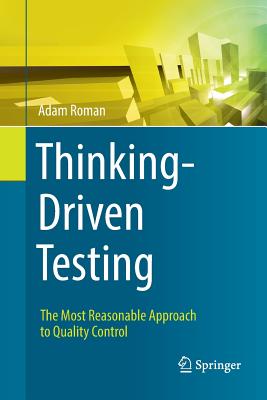Thinking-Driven Testing: The Most Reasonable Approach to Quality Control
暫譯: 思維驅動測試:最合理的品質控制方法
Roman, Adam
- 出版商: Springer
- 出版日期: 2019-01-04
- 售價: $2,470
- 貴賓價: 9.5 折 $2,347
- 語言: 英文
- 頁數: 305
- 裝訂: Quality Paper - also called trade paper
- ISBN: 3030103315
- ISBN-13: 9783030103316
海外代購書籍(需單獨結帳)
相關主題
商品描述
Chapter 1 starts by introducing the fundamental ideas underlying software testing. Chapter 2 then describes meta-strategies in software testing, i.e. general approaches that can be adapted to many different situations that a software tester encounters. Next, Chapter 3 presents the concept of Thinking-Driven Testing (TDT). This approach utilizes the concepts discussed in the two previous chapters and introduces the main ideas that underlie a reasonable and optimal approach to software testing. Chapter 4 builds on this basis and proposes a specific approach to testing, called TQED, that makes it possible to increase creativity in the context of delivering effective, optimal test ideas. Chapter 5 provides an overview of different types of testing techniques in order to understand the fundamental concepts of test design, while Chapter 6 details various pitfalls a tester may encounter and that can originate from a wide range of testing process areas. Lastly, Chapter 7 puts all this into practice, as it contains several exercises that will help testers develop a number of crucial skills: logical thinking and reasoning, thinking out of the box, creativity, counting and estimating, and analytical thinking.
By promoting critical, rational and creative thinking, this book invites readers to re-examine common assumptions regarding software testing and shows them how to become professional testers who bring added value to their company.
商品描述(中文翻譯)
本書提出了一種新的軟體測試範式,強調批判性思維、系統思維和理性作為測試者最重要的技能。因此,本書從不同於過去文獻的角度來探討軟體測試,因為絕大多數書籍都是在特定工具、自動化、文檔、特定測試設計技術或測試管理的背景下描述測試。此外,本書提出了一種新穎的元方法,用於設計有效的測試策略,該方法基於心理學、經濟學、系統科學和邏輯的最新進展。
第一章首先介紹了軟體測試的基本理念。第二章接著描述了軟體測試中的元策略,即可以適應軟體測試者所遇到的許多不同情況的一般方法。接下來,第三章介紹了思維驅動測試(Thinking-Driven Testing, TDT)的概念。這種方法利用前兩章中討論的概念,並介紹了合理和最佳的軟體測試方法的主要思想。第四章在此基礎上提出了一種具體的測試方法,稱為TQED,該方法使得在提供有效、最佳測試想法的背景下增加創造力成為可能。第五章概述了不同類型的測試技術,以便理解測試設計的基本概念,而第六章詳細說明了測試者可能遇到的各種陷阱,這些陷阱可能源自廣泛的測試過程領域。最後,第七章將所有這些付諸實踐,包含幾個練習,幫助測試者發展多項關鍵技能:邏輯思維與推理、跳出框架思考、創造力、計算與估算,以及分析性思維。
通過促進批判性、理性和創造性思維,本書邀請讀者重新檢視有關軟體測試的常見假設,並展示如何成為為公司帶來附加價值的專業測試者。
作者簡介
作者簡介(中文翻譯)
亞當·羅曼是波蘭克拉科夫雅蓋隆大學的計算機科學教授,同時也是ASQ和ISTQB認證的質量工程師和軟體測試員。他的研究興趣包括軟體質量、基於模型的測試、有效的測試案例設計、測試流程改進以及人工智慧技術在測試中的應用。他也是軟體測試領域的公認專家,曾在多個波蘭測試會議上演講,並且是波蘭資訊系統質量協會的成員。














